Cylinder drainage
|
The steam that streams into the drying cylinders condenses at the
cylinder wall during the heat dissipation. The heat is coming through the
cylinder wall up to the outside fitting paper. As a result of the heat transfer the water is evaporating and the paper is
drying.
Owing to of the steam condensation at the cylinder wall it accrues
condensate, that behaves by different revolutions as follows:
|
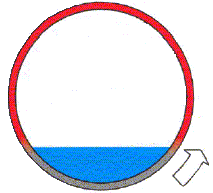
By lower speed a jump is forming.
|
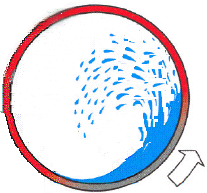
By increasing speed the condensate is cascading due to the centrifugal and gravity force. The heat
transfer is optimal.
|
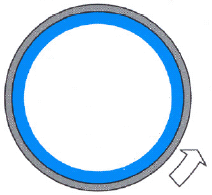
By higher speed the centrifugal force is forcing the condensate to built a ring. This water ring
reduces an efficient heat transfer, because the condensate film takes effect like
an insulation.
|
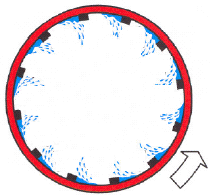
To keep the condensate film as small as possible it is necessary to install dryer bars in the
cylinder. Dryer bars are breaking the condensate ring and improves the heat
transfer.
|
Siphons
|
The condensate has to be removed out of the cylinder. The condensate exits
through the Pick-up fitting and flows together with blow through steam
through the vertical , horizontal pipe and leaves the cylinder through the
rotary joint. The siphon types are:
stationary siphons and rotary siphons
|
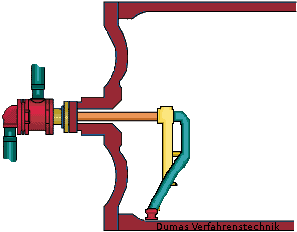
In case of stationary siphons a pipe is installed
between the lowest point and the rotary joint. This pipe drains the cylinder.
The condensate only have to pass the height distance and needs, as a result of
this, a lower differential pressure because it is not necessary to overcome the
centrifugal force like by rotary siphons .To support this technical process the
pick-up fitting is specifically formed to push the water into the pipe, to
allow lower differential pressures.
|

The rotary siphon is fixed with a vertical pipe and
rotates with the cylinder. The rotation causes a centrifugal force. As higher
the centrifugal force as higher is the needed differential pressure and the
amount of blow through steam.
|
For futher informations donīt hesitate to contakt us.
|






